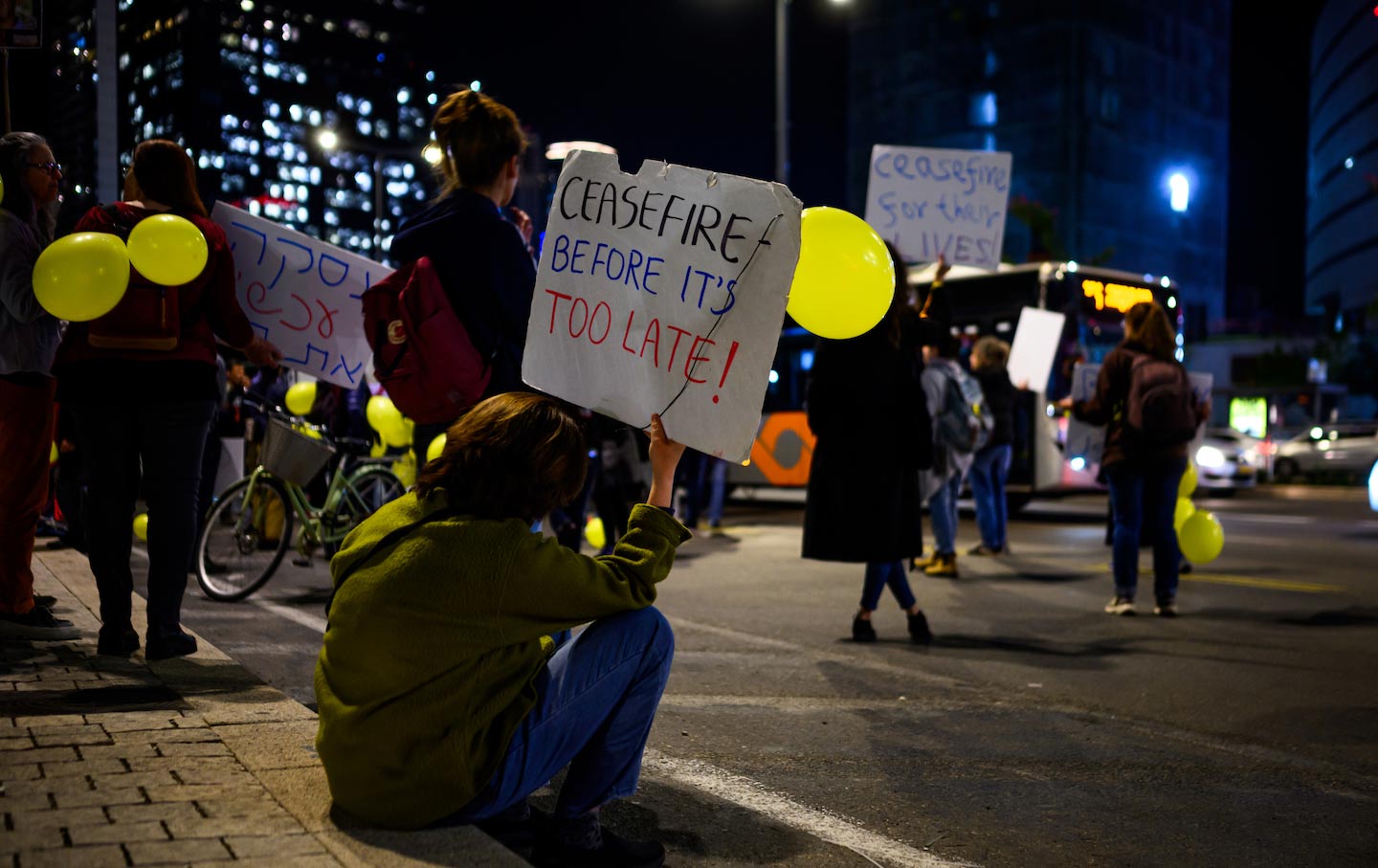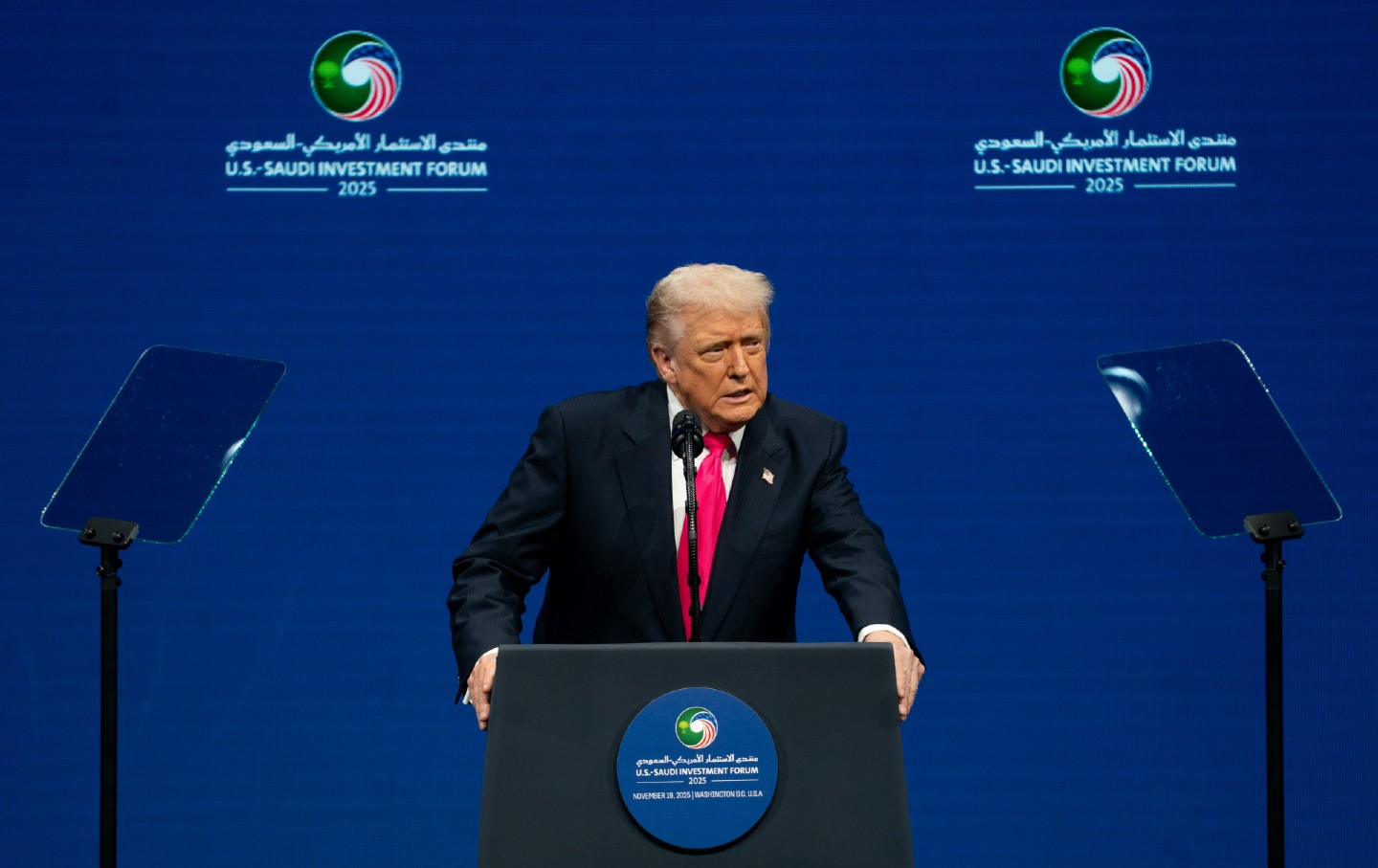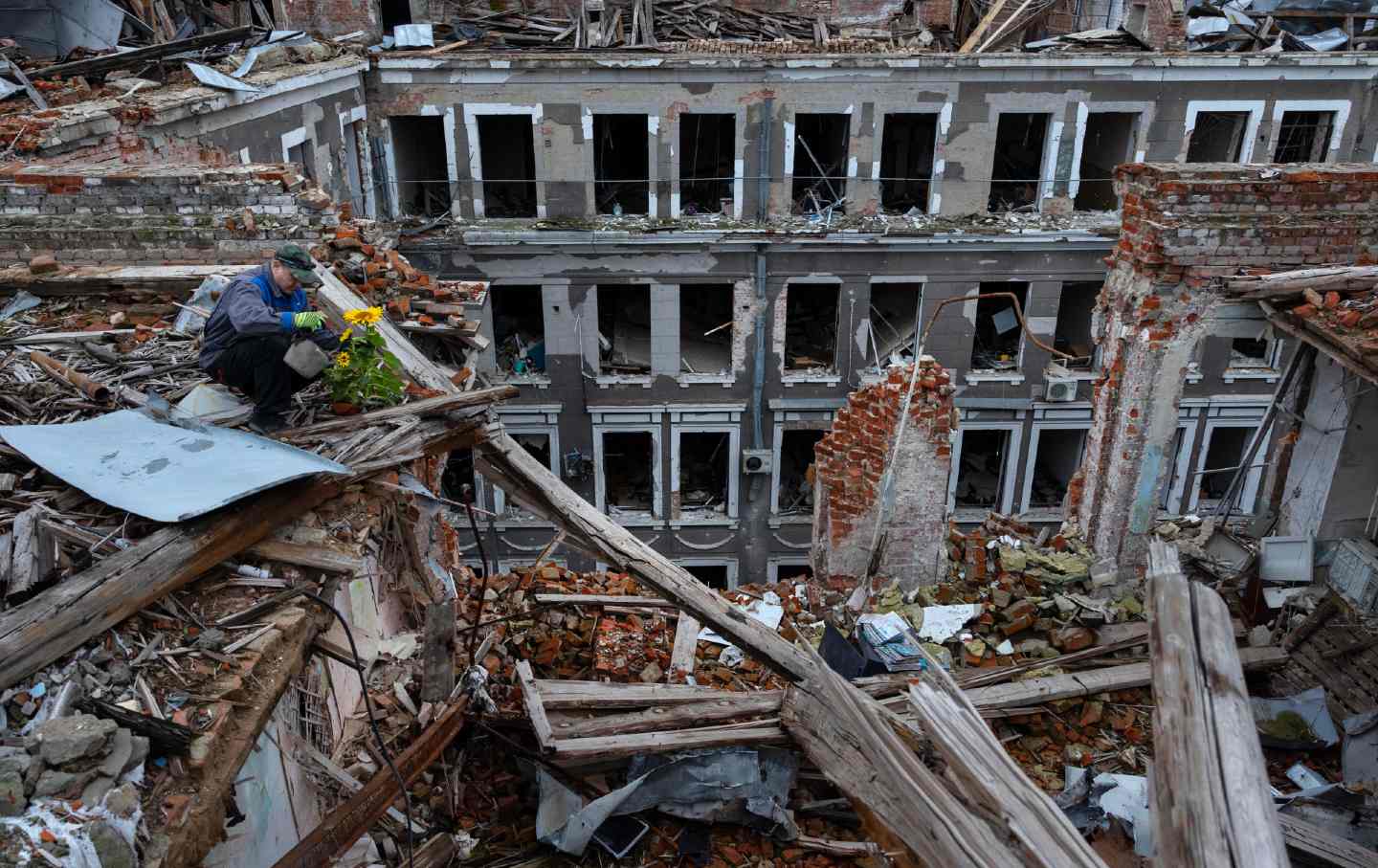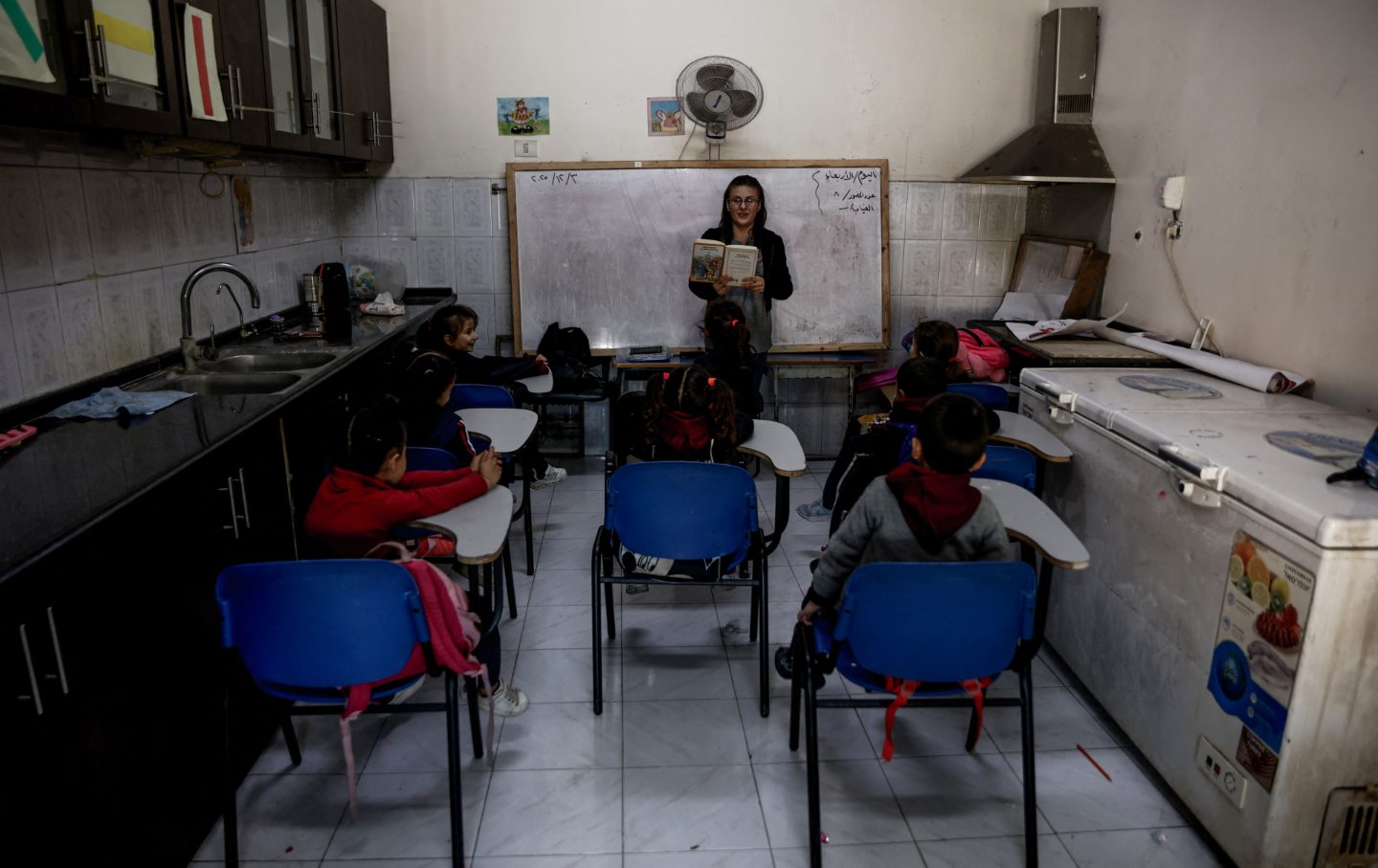Biden Redefines “Cease-Fire” to Stem Anger Over Gaza
After months of not using the term at all, the administration has embraced it, but is using it in a way that has little to do with what activists are demanding.

The pressure to back a cease-fire is immense, but the White House is unwilling to heed this call because it’s ideologically committed to Israel’s campaign of depopulation and destruction in Gaza. Instead, the Biden administration has decided to simply redefine what a “cease-fire” means. In a speech on Sunday, Vice President Kamala Harris did exactly that, calling for “an immediate cease-fire…for at least the next six weeks.” Using slippery language and deliberately vague rhetoric, the administration has subtly shifted this term away from its widespread popular meaning of an end to the Israeli bombing and siege to a temporary pause for hostage exchanges, followed by a recommencement of the conflict and return to Israel’s starvation and bombing campaign. And mainstream media outlets are letting them get away with it.
Let’s begin with what a cease-fire, as it’s broadly understood, has meant to Palestinian civil society, peace activists, and humanitarian and human rights organizations. Backed by 80 percent of Democratic voters, over 500 Biden campaign alumni, Oxfam, Amnesty International, Doctors Without Borders, 35 Arab and Jewish peace groups in Israel, and 18 United Nations agencies, this demand has been sustained and ongoing for almost five months. Since Israel dropped its first bombs in the days after October 7, and paired them with genocidal statement after genocidal statement and an open embrace of collective punishment, the endgame of the so-called “Israel-Hamas war” has been obvious: a mass killing event that, at the very least, would murder an arbitrarily high number of Palestine civilians as Bronze Age recompense and, at worst, escalate into full-blown ethnic cleansing and genocide. Anyone with the most basic knowledge of the “conflict” and Israel’s previous bombing and starvation campaigns in Gaza could easily predict the outcome of Israel’s military operations. This is why calls for a cease-fire were swift and clear: end the revenge bombing and instead solve the conflict with a sustainable, long-term political solution. After 145 days and 30,000 dead—including 15,000-plus children—more and more liberals are reaching the obvious conclusion that the nominal aim of “eliminating Hamas” is not possible militarily and, even if it were, killing tens of thousands, if not hundreds of thousands, of civilians, to achieve this goal is patently immoral.
Building a protest movement around the demand for a cease-fire was predicated on this logic, that—like all previous Israeli bombing campaigns in Gaza—it would end with Hamas, or some Hamas-like entity, remaining in power because Hamas, and other militant groups they work with, are a hybrid conventional and guerrilla force that can’t simply be bombed out of existence.
In other words, the demand for a cease-fire is a demand for Israel and its US patron to cease the pretense of “removing Hamas” as a realistic or achievable goal. As anodyne as many have worked to make such removal seem, it is impossible, unless through full-blown ethnic cleansing—as I laid out three months ago and, despite its being buried by US media, something Secretary of State Antony Blinken reportedly acknowledged in a closed-door meeting with Israeli Prime Minister Benjamin Netenyahu. As NBC’s Andrea Mitchell reported on Jan 17, “Blinken told Netanyahu that ultimately there is no military solution to Hamas, according to the officials.”
But because Biden is committed to the nominal goal of regime change in Gaza, the White House cannot and will never agree to these terms. The administration is all in on Netenyahu’s campaign of ethnic cleansing, and it’s clear that, unless there’s a radical change in the political calculus, they’re going to carry on with this nominal goal of “removing Hamas”—despite the fact that even Biden’s own secretary of state agrees that it’s impossible.
The White House also, however, recognizes that demands for a cease-fire are immensely popular, especially among Democrats and key groups they will need to win in November. Rather than changing course, and giving up the pretense of “eliminating Hamas” and forcing Israel to call it a day in Gaza, they—and partisan loyal media hacks and gullible headline writers—are trying the much easier tactic of simply redefining what a “cease-fire” means. This after months of the administration’s not using the term at all, even issuing a memo on October 13 explicitly telling staff not to use the word. But amid a nonstop torrent of war crime news reports for weeks on end, they had to finally accept that their position was untenable. So they embraced the term, but are using it in a way that has little to do with what activists are demanding. Their definition of cease-fire, as below-the-fold reporting has made clear, is not an end to the “war” or the current iteration of hostilities but a “pause” in fighting to facilitate hostage exchanges and, at least nominally, humanitarian aid. Such a pause happened for about a week in late November, but, as Euro-Med Human Rights Monitor noted at the time, Israel simply increased its killing by 40 percent the week after to make up for lost time.
This isn’t to say a temporary pause in the fighting to exchange prisoners is a bad thing. Any cessation of killing would be an improvement over the status quo, obviously. And it’s possible, albeit a slim chance, that the White House wants to use the pause in fighting to achieve a longer-lasting peace. But this is not what they say their aim is, and they’ve been very consistent on this. In an interview with The New Yorker’s Isaac Chotiner on Wednesday, White House National Security Council spokesman John Kirby stated emphatically, “Nothing’s changed [in the White House’s policy]. We still don’t support a general ceasefire that would leave Hamas in charge. What we do support is a temporary ceasefire, to get these hostages out and get the aid in.”
That clarification is easy to miss when compliant media outlets have failed to challenge the administration on its position. When Biden announced on February 26, while eating ice cream, that the White House was optimistic they were about to have something called a “cease-fire,” it had its intended effect. The president was rewarded with misleading headlines that left the average media consumer with the impression that the White House’s goal is a cease-fire in the sense in which it’s generally understood: an end to the war.
- NPR: “Biden says there could be a cease-fire in Gaza by Monday. Talks are still ongoing”
- NBC News: “Biden says he hopes to see a cease-fire by next week in the Israel-Hamas war”
- BBC: Israel Gaza: “Biden hopes for ceasefire by next week”
- CNN: “Biden says he hopes there’ll be a ceasefire in Gaza by next Monday”
- MSNBC: “Biden says ‘we’re close’ on Israel-Hamas ceasefire”
- CBS News: “Biden says he hopes for Israel-Hamas cease-fire by Monday”
- ABC News: “Biden hopes cease-fire, hostage deal to pause Israel-Hamas war can take effect by next Monday”
The only mainstream outlet to even come close to making this distinction was The Washington Post, whose headline “Biden says temporary cease-fire in Gaza could come next week” at least conveyed the idea this was a pause in hostilities, not a call to end the war.
Biden’s use of the term was doubly cynical because it was on the eve of the Michigan primary, which saw over 100,000 voters cast “uncommitted” ballots as a protest against the president’s Gaza policy—a protest campaign several reports said had the White House and Democratic Party strategists worried. Clearly, there was a messaging shift, a shift the White House embraced because the administration rightly assumed very few in the media would seek to clarify what was being said versus what was being implied.
Partisan media writers like Semafor’s Jordan Weissmann would go further, tweeting out, “I feel like we’ve reached an odd juncture in the Gaza debate where Biden is in fact publicly pushing for a cease-fire—albeit a temporary one, as a step towards a longer term cessation—but protestors only sort of seem to be half-acknowledging it, if that.”
Popular
“swipe left below to view more authors”Swipe →But, as Kirby and Biden have repeatedly made clear, they are not pushing for a cease-fire in the way “protesters” generally mean it, as a pause in fighting pursuant to an end to the current hostilities. Weissmann’s caveat, “albeit a temporary one,” entirely undermines his point. Both Kirby and Netenyahu have been clear that a pause in fighting to exchange more hostages is just a lunch break before the biggest invasion yet, not “a step towards a longer term cessation.” The Israeli prime minister has expressly said, on a number of occasions, that any pause for hostage exchanges will not stop the bombing campaign and pending invasion of Rafah, where 1.4 million Palestinians have sought refuge.
Mainstream media outlets have a responsibility to clarify these slippery terms. If the White House’s goal is to get Israel to agree to a temporary pause in the hope that it can be parlayed into a longer-lasting cease-fire that approximates what humanitarian organizations are asking for, then the White House should say so. But they have repeatedly said the opposite, so using the term “cease-fire” in the way that they have is confusing and manipulating readers.
And make no mistake, as The Guardian’s Mehdi Hasan recently laid out in detail, the president can end the conflict whenever he wants. Israel cannot militarily function beyond a few weeks without being resupplied with bombs, artillery shells, and intelligence support, nor can it possibly sustain a war on three fronts. Everyone knows and Israel officials routinely acknowledge this, thus no arduous, 16-dimensional chess is necessary to achieve a cease-fire. It’s something the White House can impose more or less overnight. The image of the president and his diplomats struggling and bumbling through back channels to achieve it is part theater and part a misunderstanding among the general public of what it is they are working toward, which is maintaining lockstep support for the Gaza siege and bombing but getting a pause to bring home hostages—something Netanyahu is under tremendous domestic pressure to do. The latter is being conflated with the former to dupe liberals into thinking Biden wants to end the war but simply cannot. An image Biden aides actively curate with their nonstop flood of stories claiming that behind closed doors the president is “increasingly frustrated” or “growing distant” to Netanyahu. But this is fiction, a media device—like redefining “cease-fire”—to buy time and confuse casual media consumers.
After all, working to change the definition of a single word is exponentially easier than admitting that a major foreign policy position has been a murderous disaster.
Disobey authoritarians, support The Nation
Over the past year you’ve read Nation writers like Elie Mystal, Kaveh Akbar, John Nichols, Joan Walsh, Bryce Covert, Dave Zirin, Jeet Heer, Michael T. Klare, Katha Pollitt, Amy Littlefield, Gregg Gonsalves, and Sasha Abramsky take on the Trump family’s corruption, set the record straight about Robert F. Kennedy Jr.’s catastrophic Make America Healthy Again movement, survey the fallout and human cost of the DOGE wrecking ball, anticipate the Supreme Court’s dangerous antidemocratic rulings, and amplify successful tactics of resistance on the streets and in Congress.
We publish these stories because when members of our communities are being abducted, household debt is climbing, and AI data centers are causing water and electricity shortages, we have a duty as journalists to do all we can to inform the public.
In 2026, our aim is to do more than ever before—but we need your support to make that happen.
Through December 31, a generous donor will match all donations up to $75,000. That means that your contribution will be doubled, dollar for dollar. If we hit the full match, we’ll be starting 2026 with $150,000 to invest in the stories that impact real people’s lives—the kinds of stories that billionaire-owned, corporate-backed outlets aren’t covering.
With your support, our team will publish major stories that the president and his allies won’t want you to read. We’ll cover the emerging military-tech industrial complex and matters of war, peace, and surveillance, as well as the affordability crisis, hunger, housing, healthcare, the environment, attacks on reproductive rights, and much more. At the same time, we’ll imagine alternatives to Trumpian rule and uplift efforts to create a better world, here and now.
While your gift has twice the impact, I’m asking you to support The Nation with a donation today. You’ll empower the journalists, editors, and fact-checkers best equipped to hold this authoritarian administration to account.
I hope you won’t miss this moment—donate to The Nation today.
Onward,
Katrina vanden Heuvel
Editor and publisher, The Nation
More from The Nation

The US Is Looking More Like Putin’s Russia Every Day The US Is Looking More Like Putin’s Russia Every Day
We may already be on a superhighway to the sort of class- and race-stratified autocracy that it took Russia so many years to become after the Soviet Union collapsed.

Israel Wants to Destroy My Family's Way of Life. We'll Never Give In. Israel Wants to Destroy My Family's Way of Life. We'll Never Give In.
My family's olive trees have stood in Gaza for decades. Despite genocide, drought, pollution, toxic mines, uprooting, bulldozing, and burning, they're still here—and so are we.

Trump’s National Security Strategy and the Big Con Trump’s National Security Strategy and the Big Con
Sense, nonsense, and lunacy.

Does Russian Feminism Have a Future? Does Russian Feminism Have a Future?
A Russian feminist reflects on Julia Ioffe’s history of modern Russia.

Ukraine’s War on Its Unions Ukraine’s War on Its Unions
Since the start of the war, the Ukrainian government has been cracking down harder on unions and workers’ rights. But slowly, the public mood is shifting.

I’m a Teacher in Gaza. My Students Are Barely Hanging On. I’m a Teacher in Gaza. My Students Are Barely Hanging On.
Between grief, trauma, and years spent away from school, the children I teach are facing enormous challenges.


